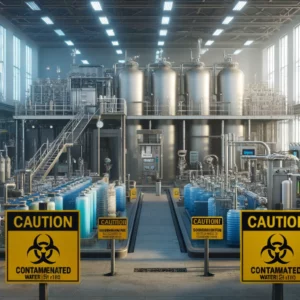Environmental Concerns Rise Following Accidental Discharge at Maine Airport
An accidental release of firefighting foam at Brunswick Executive Airport in Maine on August 19, 2024, has prompted a comprehensive cleanup operation and raised environmental concerns. The incident led to a multi-agency response to mitigate potential environmental impacts and ensure public safety.
5 Key Points
- 1,450 gallons of aqueous film-forming foam (AFFF) released at Brunswick Airport
- Cleanup operations involve hangar and aircraft decontamination
- PFAS contamination detected in nearby retention ponds
- New fish consumption advisories issued for local waterbodies
- Ongoing monitoring and remediation efforts in place
Incident Overview and Immediate Response
On August 19, 2024, Brunswick Executive Airport experienced an unexpected discharge of 1,450 gallons of aqueous film-forming foam (AFFF), a type of firefighting foam known to contain per- and polyfluoroalkyl substances (PFAS). The release prompted an immediate response from local and state authorities, highlighting these chemicals’ potential environmental and health risks.
In the wake of the incident, Clean Harbors and Republic Services were contracted to lead the cleanup efforts, operating under the oversight of the Maine Department of Environmental Protection (DEP). This swift action underscores the seriousness of PFAS contamination and the need for specialized handling of such incidents.
Comprehensive Cleanup Operations
The cleanup process has been extensive and meticulous, reflecting the complex nature of PFAS contamination. As of August 27, 2024, officials reported that the affected hangar at Brunswick Landing had been thoroughly cleaned, with all discharged foam successfully removed. This process involved decontaminating the hangar itself and thoroughly cleaning the impacted aircraft.
The cleanup operation extends beyond the immediate site of the discharge. Contracted crews are working diligently to contain and remediate affected areas, employing various techniques to minimize the spread of contaminants. The process includes:
- Multiple rounds of cleaning for affected aircraft
- Steam cleaning of impacted industrial spaces in TechPlace
- Deployment of four vacuum trucks to remove foam from affected surface water retention ponds
- Out-of-state disposal of all collected PFAS-impacted water from response activities
These comprehensive measures highlight the challenges posed by PFAS contamination and the resources required to address such incidents effectively.
Environmental Impact and Monitoring
The release of AFFF at Brunswick Airport has raised significant environmental concerns, particularly regarding water contamination. Four surface water retention ponds have been impacted, with ongoing foam formation observed. This persistent foaming, which weather conditions and rainfall may exacerbate, presents a continued challenge for cleanup crews and environmental monitors.
The Maine DEP has taken a proactive approach to assess the environmental impact:
- Surface water samples have been collected from the retention ponds and Harpswell Cove.
- Four samples taken on the day of the spill revealed PFOS as the primary compound detected.
- PFOS levels varied significantly across sampling sites, from 3,230 parts per million (ppm) in the AFFF storage tank to 0.000701 ppm at the outlet of a surface water pond
These findings guide immediate remediation actions and will inform ongoing monitoring efforts to track potential long-term impacts on local ecosystems.
Public Health Considerations
While officials have assured that the public water supply remains unaffected by the incident, the release has prompted new public health advisories. On August 25, 2024, the Maine Center for Disease Control and Prevention (Maine CDC) issued freshwater fish consumption advisories for four waterbodies near the former naval air station.
These advisories recommend either no consumption or limited consumption of fish from the affected areas, highlighting the potential for PFAS bioaccumulation in aquatic ecosystems. This precautionary measure underscores the broader implications of PFAS contamination on local food sources and public health.
Ongoing Challenges and Future Implications
As cleanup efforts continue, several challenges and questions remain:
1. The persistence of foam in retention ponds, with uncertainty about its duration
2. Potential for increased foam production due to weather conditions and water agitation
3. Long-term environmental impacts, particularly on aquatic ecosystems and wildlife
4. Public health concerns related to PFAS exposure and bioaccumulation
The incident at Brunswick Airport is a stark reminder of the environmental and health risks associated with PFAS-containing firefighting foams. It raises crucial questions about the continued use of these substances and the need for safer alternatives in firefighting and other industrial applications.
FAQ
Q: Do you qualify for a firefighting foam lawsuit?
A: To see if you qualify, click here.
Q: What caused the release of firefighting foam at Brunswick Airport?
A: The article doesn’t specify the exact cause, describing it as an accidental discharge of 1,450 gallons of AFFF.
Q: How is the cleanup being conducted?
A: Cleanup involves decontaminating hangars and aircraft, removing foam from retention ponds, and disposing of contaminated water out-of-state.\
Q: Are there any health risks for residents?
A: While the public water supply is reportedly unaffected, new fish consumption advisories have been issued for nearby waterbodies.
Q: What are the main environmental concerns?
A: The primary concerns are PFAS contamination in surface water, potential impacts on aquatic life, and the persistence of foam in retention ponds.
Q: How long will the cleanup and monitoring efforts continue?
A: The article doesn’t specify an end date, suggesting ongoing efforts will continue as needed to address contamination and monitor long-term impacts.
Citations:
Bartow, A. (2024, August 27). Hangar and planes cleaned following release of firefighting foam at Brunswick airport. WMTW. https://www.wmtw.com/article/hangar-planes-cleaned-release-firefighting-foam-brunswick-maine-airport/61982774







